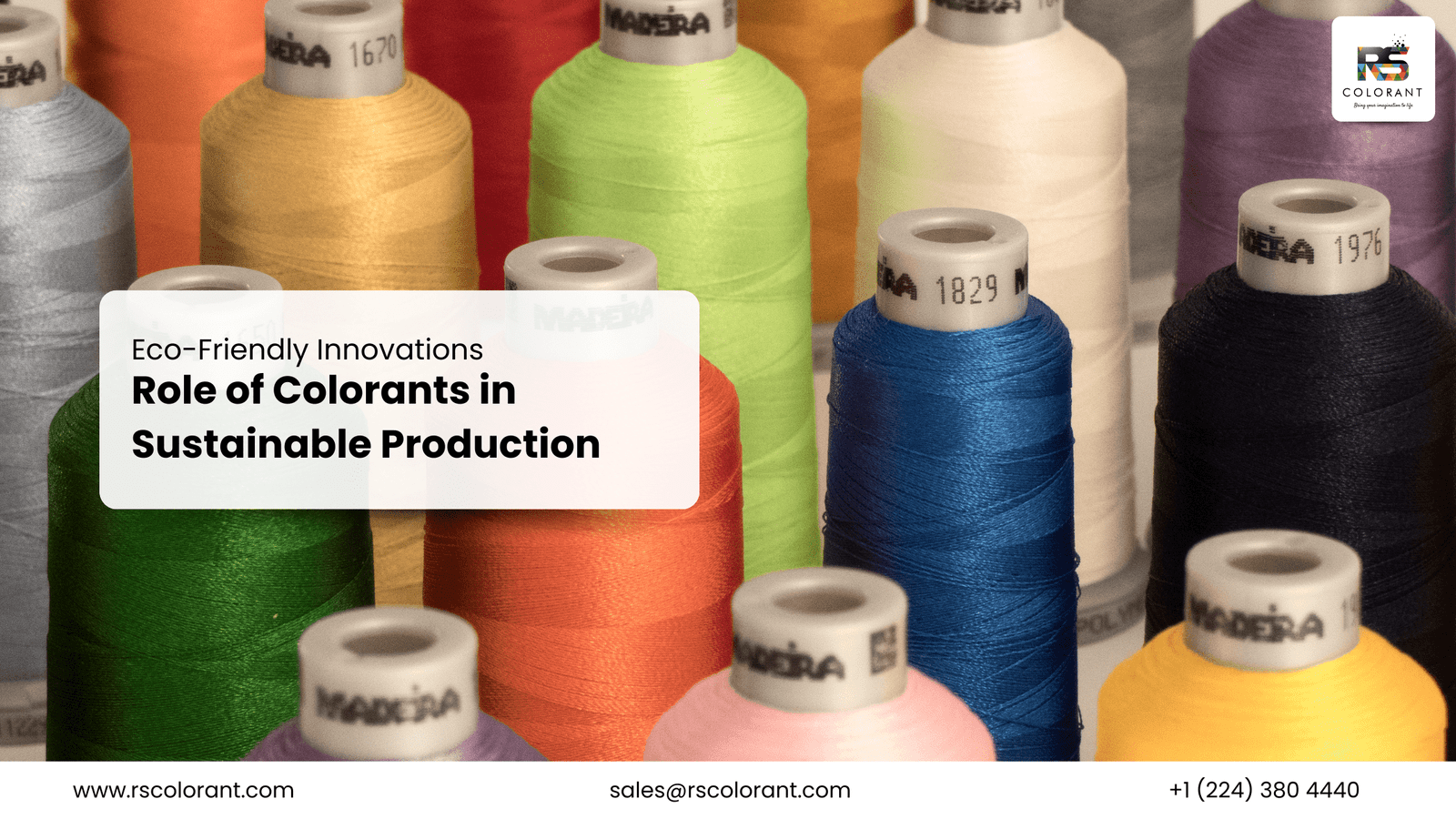Sustainable Colorants – Outline
- Introduction
- The importance of sustainability in modern production
- Overview of colorants in various industries
- What Are Colorants?
- Definition and types of colorants
- Natural vs. synthetic colorants
- Historical Use of Colorants
- Early use of natural dyes
- Evolution to synthetic colorants
- Environmental Impact of Traditional Colorants
- Pollution from synthetic dyes
- Health risks associated with conventional colorants
- The Shift Towards Sustainable Colorants
- Growing consumer demand for eco-friendly products
- Regulatory pressures and industry response
- Types of Sustainable Colorants
- Natural colorants
- Bio-based colorants
- Recycled colorants
- Benefits of Sustainable Colorants
- Environmental benefits
- Economic advantages
- Health and safety improvements
- Challenges in Adopting Sustainable Colorants
- Technical challenges
- Cost implications
- Market acceptance
- Case Studies of Sustainable Colorant Use
- Fashion industry
- Food and beverage industry
- Packaging industry
- Innovations in Sustainable Colorant Technology
- Advances in bioengineering
- Green chemistry innovations
- Regulations and Standards
- Key regulations promoting sustainable colorants
- Certification and labeling schemes
- The Role of Consumer Awareness
- The power of consumer choice
- Educating consumers about sustainable options
- Future Trends in Sustainable Colorants
- Predicted market growth
- Emerging technologies
- How to Choose Sustainable Colorants for Your Business
- Factors to consider
- Tips for transitioning to sustainable options
- Conclusion
- Recap of key points
- The future outlook for sustainable colorants
- FAQs
- What are sustainable colorants?
- Are natural colorants always better for the environment?
- How can businesses transition to using sustainable colorants?
- What are some common industries using sustainable colorants?
- How do sustainable colorants impact product quality?
The Role of Colorants in Sustainable Production
Introduction
In a world increasingly conscious of environmental impact, sustainability has become a key focus across industries. Among the various elements that contribute to sustainable production, colorants play a significant yet often overlooked role. Colorants are crucial in industries ranging from textiles and food to cosmetics and packaging. Understanding their impact and transitioning to sustainable alternatives can lead to more eco-friendly production processes.
What Are Colorants?
Colorants are substances used to impart color to materials, enhancing their appearance and appeal. They come in various forms, including dyes, pigments, and additives, and can be classified into two broad categories: natural and synthetic.
- Natural Colorants: Derived from plants, animals, and minerals, examples include indigo, cochineal, and ochre.
- Synthetic Colorants: Chemically produced, these include azo dyes and synthetic pigments like titanium dioxide.
Historical Use of Colorants
Colorants have a rich history, with early humans using natural dyes from plants and minerals to color fabrics and artworks. The industrial revolution marked a significant shift with the invention of synthetic dyes, which offered more vibrant colors and greater stability. However, this shift came with environmental costs.
Environmental Impact of Traditional Colorants
Traditional synthetic colorants have been associated with significant environmental pollution. The production and disposal processes often release harmful chemicals into waterways, contributing to water pollution and posing health risks to communities and wildlife. These issues underscore the urgent need for more sustainable alternatives.
The Shift Towards Sustainable Colorants
The demand for sustainable products is on the rise, driven by consumers’ growing environmental awareness and stricter regulatory frameworks. Industries are responding by exploring and adopting sustainable colorants that minimize environmental impact.
Types of Sustainable Colorants
Natural Colorants: These are extracted from renewable sources such as plants and insects. Examples include turmeric, beetroot, and cochineal.
Bio-based Colorants: These are derived from biological sources and may involve biotechnological processes. They offer a sustainable alternative to purely natural extracts.
Recycled Colorants: Made from waste materials, these colorants help in reducing overall waste and promoting circular economy principles.
Benefits of Sustainable Colorants
Sustainable colorants offer multiple advantages:
- Environmental Benefits: They reduce pollution and reliance on non-renewable resources.
- Economic Advantages: While initially more expensive, they can lead to cost savings through reduced waste and improved efficiency.
- Health and Safety Improvements: They often involve fewer toxic chemicals, benefiting both workers and consumers.
Challenges in Adopting Sustainable Colorants
Despite the benefits, several challenges hinder the widespread adoption of sustainable colorants:
- Technical Challenges: Achieving consistency and performance comparable to synthetic colorants can be difficult.
- Cost Implications: Sustainable colorants can be more expensive due to higher raw material costs and complex production processes.
- Market Acceptance: Convincing consumers and businesses to switch to sustainable options requires significant effort and education.
Case Studies of Sustainable Colorant Use
Fashion Industry: Brands like Patagonia and Stella McCartney are pioneers in using natural dyes and recycled colorants in their collections.
Food and Beverage Industry: Companies like Mars and Nestlé are shifting towards natural food colorings to meet consumer demand for cleaner labels.
Packaging Industry: Innovators are developing bio-based inks and colorants for sustainable packaging solutions.
Innovations in Sustainable Colorant Technology
Advances in technology are driving the development of more efficient and sustainable colorants. Bioengineering is producing new natural dyes, while green chemistry innovations are reducing the environmental footprint of colorant production.
Regulations and Standards
Several regulations and certification schemes are promoting the use of sustainable colorants:
- Key Regulations: The European Union’s REACH regulation and the US Toxic Substances Control Act.
- Certification Schemes: GOTS (Global Organic Textile Standard) and the Cradle to Cradle certification.
The Role of Consumer Awareness
Consumer awareness plays a crucial role in driving the adoption of sustainable colorants. Educated consumers are more likely to choose eco-friendly products, influencing market trends and encouraging manufacturers to adopt sustainable practices.
Future Trends in Sustainable Colorants
The future of sustainable colorants looks promising, with predicted market growth and ongoing innovations in biotechnology and green chemistry. Emerging technologies like synthetic biology and nanotechnology hold the potential to revolutionize the production and application of colorants.
How to Choose Sustainable Colorants for Your Business
Businesses looking to transition to sustainable colorants should consider several factors:
- Source and Composition: Ensure colorants are derived from renewable or recycled materials.
- Performance and Stability: Test for colorfastness, vibrancy, and compatibility with existing production processes.
- Certifications: Look for certified sustainable colorants to ensure compliance with environmental standards.
Conclusion
The shift towards sustainable colorants is not just a trend but a necessary evolution in responsible production. As industries and consumers become more environmentally conscious, the demand for sustainable solutions will continue to grow. Embracing sustainable colorants can lead to a healthier planet, innovative products, and a better future for all.
FAQs
What are sustainable colorants? Sustainable colorants are dyes and pigments made from renewable, bio-based, or recycled materials, designed to reduce environmental impact.
Are natural colorants always better for the environment? Not necessarily. While natural colorants can be more eco-friendly, their production can sometimes involve significant land and water use. Sustainable practices and certifications are essential.
How can businesses transition to using sustainable colorants? Businesses can start by researching and sourcing certified sustainable colorants, testing them for performance, and gradually integrating them into their production processes.
What are some common industries using sustainable colorants? Industries like fashion, food and beverage, cosmetics, and packaging are increasingly adopting sustainable colorants to meet consumer demand and regulatory requirements.
How do sustainable colorants impact product quality? When chosen and applied correctly, sustainable colorants can maintain or even enhance product quality, offering vibrant colors and improved safety profiles.




